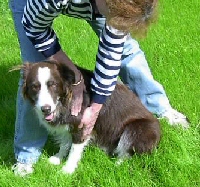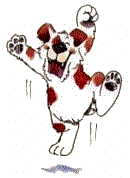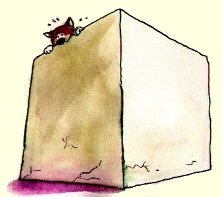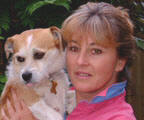Your Dog is a Canine Athlete
|
|
|
Co-sponsors of the 2023 Winning Out
Certificates |
Massage can improve your dog's performance and health...
|
|
It was very pleasing to see the importance of canine massage highlighted when I saw the article put forward by Paula Kingswood on canine massage and stretching for the agility dog. This is an area where I have been working very successfully as a Canine and Equine therapist for quite a while. My heart sinks when I attend a show and see dogs being trotted around for a minute or two then stood in line, then be put through a gruelling and highly testing course that would push any athlete to their maximum.
To condition a dog for agility, both physically and mentally, is a long process, and part of that process should and must be a very strict regime of warming up and warming down, plus specific massage techniques. Massage does not replace warming up or down, but it is an incredibly important addition that will identify and target specific muscles under the most duress.
The following are examples of contra-indications (when NEVER) to massage and ‘stretching’ of the healthy dog in the agility ‘arena’ |
Case Study
This was such a fantastic achievement and Lisa has always, very generously said that Billy’s full potential was produced by Galen Therapy Centre’s correct injury management procedure, good remedial therapy and a continued programme of pre and post event massage trained by Galen and carried out by Lisa. Billy is now nine years old and still competing. I give him a check up every few of weeks during the season, a couple of minor adjustments but he is in peak muscular condition. Equally as important because of her ‘hands on approach’, Lisa is totally in touch with all her dog's health. She has been massaging on a regular basis for over a year and has seen such benefits in all her dogs, but perhaps one of the most important aspects is that she is fully aware of her dogs' musculature, and knows when something is not quite right. This is a great addition to her skills and a wonderful gift for her dogs' prolonged health. Photo reproduced kind permission West Sussex County Times |
You must not massage if your dog:-
There are other situations when massage is not advised but these would be the most common within a working agility situation.
 Passive
movement
Passive
movement
No dog should really be stretched, (as opposed to the dog stretching themselves)
instead each joint should be gently taken through its natural range of movement. This is called
‘passive movement’. There are two reasons for this, first stretching can exacerbate a problem
and force the joint against the dogs’ will, especially if the key joints are not being
supported appropriately by the handler. Secondly, there is no reason why the joint should be
taken beyond its own natural range, through a stretch, as the natural range for a joint
is exactly what the dog will be utilising during the discipline, and stretching beyond has been
proven to in some cases promote injury by over stretching the target muscles. Now, many
athletes do the same, as the huge benefits of passive movement and the positive influences on
the joints been proven in both sports and remedial therapy.
When adopting a passive movement regime for your dog you must always:-
 Before
and after
Before
and after
Something that everyone can begin to do even if you are a little nervous about
massage is:-
Warming up should be down in a slow, methodical manner, that actively warms all the target muscles required for the event or training. The vertebrae or spine should also be included so circling should also be in the routine. Some handlers incorporate ‘tricks’ that make it fun for the dogs, but thought must be given to what is being achieved. Warming up the muscles increases the flow of blood to the fibres and therefore washes the muscles with new blood containing oxygen and nutrients, and warm muscles are more contractile therefore there is lesser chance of injury.
Warming down is so important to cleanse the muscles, and you both do it together maybe you handlers will wake up in the morning feeling less stiff also!! Warming down is not a slow walk, it is best as a slow jog, a pendulum type gait, that does not take too much energy but is rhythmic and calming. Finish with a collected walk until the dog is looking balanced and calm. This followed by an appropriate ‘lymphatic drainage’ type massage will benefit your dog hugely! By doing this each time you may prolong your dogs working and quality of life by many years!
Sue Dennison’s dog Buddy is a classic case. She now adopts a very strict regime and always applies a warm down programme and massage, her dog Buddy is still competing very successfully again this season after she thought at the beginning of last he would not be running again, due to his progressive stiffness post event. The change in his post event physical state changed almost overnight with the lack of lactic acid in his muscles they did not hurt and, therefore, he was no longer stiff.
 Injury
management
Injury
management
Another area that can have an immediate impact is injury management. If the dog has
suffered an injury, however slight, the first few hours of a management are key to how the soft
tissue forms its healing matrix. Muscle scarring - muscle forms scars in the same way as skin -
can cause a huge reduction of the muscle ability to contract. If a muscle is not stretching and
contracting as it should, then it will cause an issue at the connecting joint and cause
imbalance. This in turn can cause the joint to be compromised and excessive wear on the
articulating surfaces, and eventually arthritis.
If cold is applied to the area of injury or to where there is heat straight away and kept on for 10-15 minutes and repeated if heat continues, inflammation will be reduced and less scarring occur. This is slightly complex, and the argument could be that ‘nature knows best.’ That is true in most cases. However with muscular injury, when the muscle fibres are damaged and, therefore, the contents of the cells and fibres burst, to the body these are viewed as toxins and, therefore, blood flows freely to this area to flood and cleanse as it would with any other toxin. This is a total over reaction to the whole situation and, in fact, what happens is that surrounding areas that were undamaged become involved and the area of ‘damage’ increases. By icing this reaction is reduced and the ice encourages oxygen to the area that promotes healing.
Rest is critical at this stage and no exercise should be actively participated in for at least 72 hours, and only then if there is NO signs of pain or discomfort from the dog. At this time appropriate massage aids the healing process by influencing the drainage of interstitial fluid, benefiting the healing and hugely reducing the risk of any muscle scarring. If symptoms persist or you are in any way concerned, contact your veterinary surgeon.
How
to detect an injury?
Apart from the obvious lameness, the short answer to that is to be aware of your
dogs’ body temperatures. This will become second nature to people who massage regularly, and
become very familiar with their dogs temperature over major joints and muscle groups. Cold
should be applied on the effected areas - gel pads are the best but when there has been nothing
else, I have used a Coke can! If you are using a block straight from the freezer, wrap it in a
cloth before applying it to your dog.
Within my remedial therapy work with dogs, arthritis is far too common, but believe it or not, generally I can track the commencement of the bony change (or arthritis) back to an injury or incident, even down to apparent minor, falling off a chair! We can not help accidents, but we must try and prevent unnecessary injury through accidents that were caused because the dog was not in the correct physiological condition - whether it be in agility or on a family walk -and by taking appropriate action to manage any injury.
A dog ‘makes light’ of covering the ground. Don't be fooled by underestimating the concussion of the impact and stresses being asserted, especially through their shoulders that are held on to their bodies by just muscle alone! Be aware that your dog is a finely tuned athlete. Please treat them with the care management they require and deserve for a long happy and healthy life!
References:
Sports Injuries by Lars Peterson and Per Renstrom (3rd edition) (Martin Dunitz
The Healing Touch by Dr. Michael W. Fox (Newmarket Press)
 About
the author...
About
the author...
Julia Robertson is the principal at Galen Therapy Centre and is a qualified
Canine and Equine Sports and remedial massage therapist, working independently upon Veterinary
referral, and within a busy veterinary practice as their consultant physical therapist. She has
always worked with animals both as a Veterinary Nurse and, for most of her life as an active
working partner on a large dairy farm.
She was aware from many years ago that there seemed to be a gap in the health care of animals, after her Labrador puppy lost mobility in his neck and was recommended to be put down! She actively sought a horse osteopath who explained that it was probably a soft tissue injury and recommended massage. That was ten years ago and Huffo still lives! Her greatest inspiration was her Newfoundland Panda who died 18 months ago (aged 15) enjoying a full, active and healthy muscular life. Panda features on the trade mark.
|
* If you would like to know more about how to massage, Galen Therapy Centre are releasing a DVD early august that will demonstrate how to give and pre and post-event massage and explain exactly how massage works and when not to apply. The film will also demonstrate how a dog moves the muscles required for different disciplines and a study of the stresses put upon these. If you are interested, you can reserve your copy at www.caninetherapy.co.uk If however, you are interested in learning how to practice a course in now available through the Animal Care College and Galen Therapy Centre. Website www.galentherapycentre.co.uk or www.caninetherapy.co.uk or the animal care college www.animalcarecollege.co.uk . |
|
[bottom.htm]
© Copyright Agilitynet
|